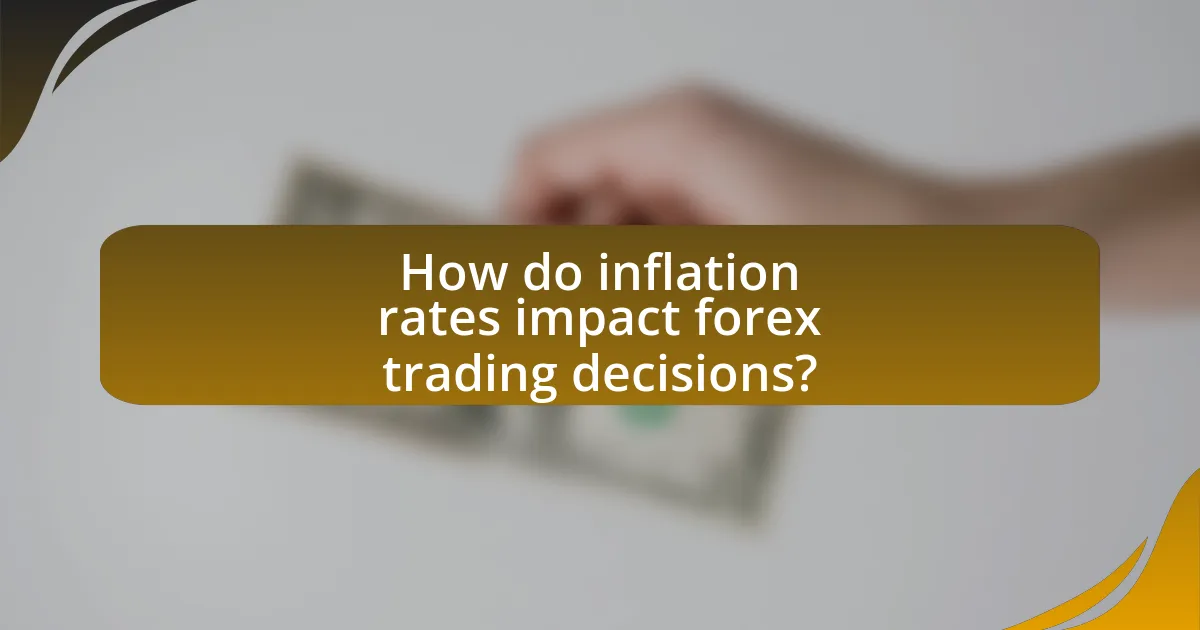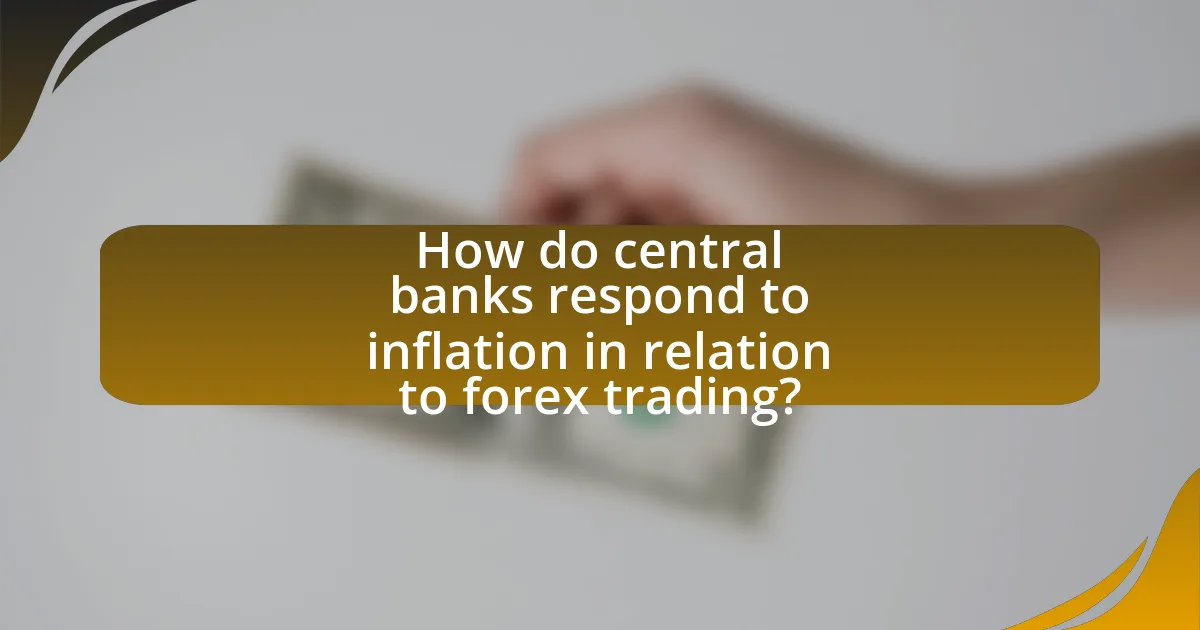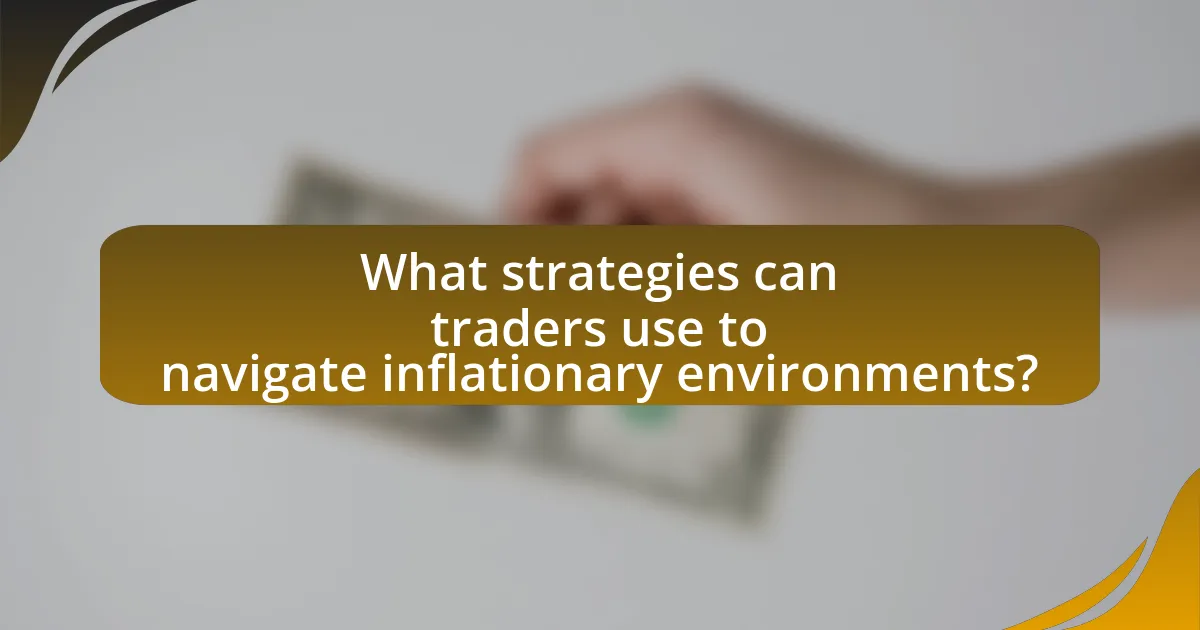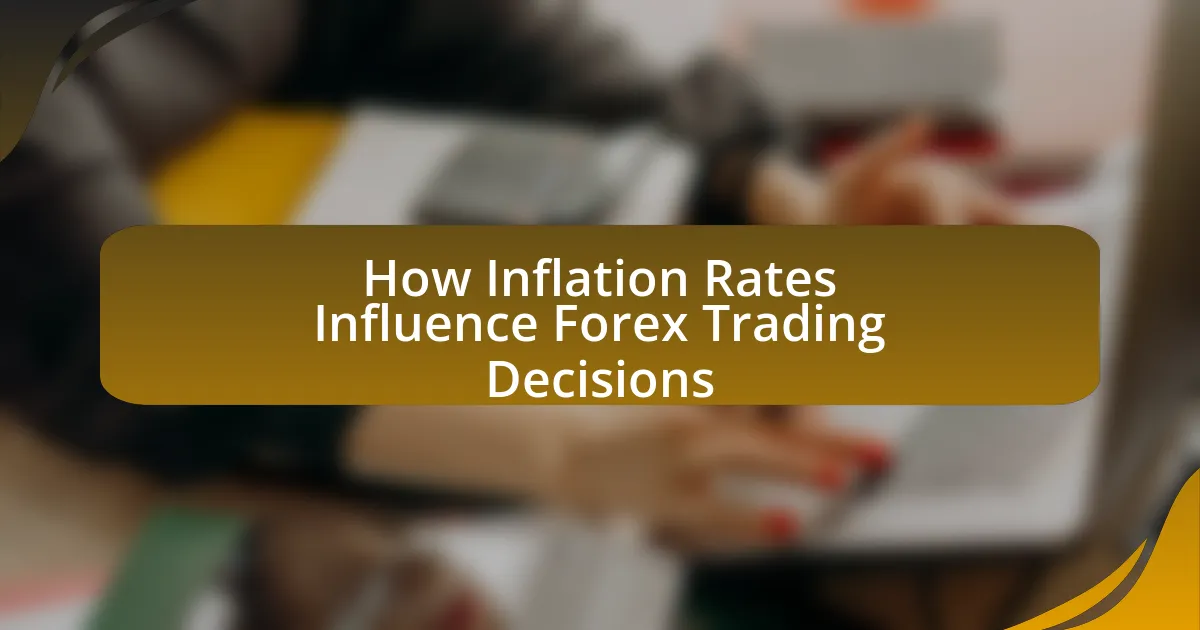The article examines how inflation rates influence forex trading decisions, highlighting the relationship between inflation and currency value, purchasing power, and interest rates. It discusses the impact of inflation on currency depreciation, the importance of monitoring inflation indicators, and the role of central banks in adjusting monetary policy to manage inflation. Additionally, the article outlines strategies traders can employ to navigate inflationary environments, including diversification and hedging techniques, while emphasizing common mistakes to avoid during such periods. Key inflation indicators, such as the Consumer Price Index and Producer Price Index, are identified as critical tools for traders to anticipate market movements and adjust their trading strategies accordingly.

How do inflation rates impact forex trading decisions?
Inflation rates significantly impact forex trading decisions by influencing currency value and investor sentiment. When inflation rises in a country, its currency typically depreciates due to decreased purchasing power, prompting traders to sell that currency. For example, if the U.S. experiences higher inflation than the Eurozone, the U.S. dollar may weaken against the euro, leading traders to adjust their positions accordingly. Historical data shows that a 1% increase in inflation can lead to a corresponding decrease in currency value, as seen during the inflation spikes in the 1970s, which affected the U.S. dollar’s strength. Thus, traders closely monitor inflation reports to make informed decisions about currency pairs.
What is the relationship between inflation and currency value?
Inflation inversely affects currency value; as inflation rises, the purchasing power of a currency declines. This relationship is evident in economic theory, where higher inflation rates typically lead to depreciation of the currency in foreign exchange markets. For instance, if a country experiences a 3% inflation rate while another country maintains a 1% rate, the currency of the country with higher inflation is likely to weaken against the other. Historical data supports this, as seen in the hyperinflation in Zimbabwe during the late 2000s, where the currency lost significant value due to rampant inflation, leading to a collapse in its purchasing power.
How does inflation affect purchasing power in forex markets?
Inflation decreases purchasing power in forex markets by eroding the value of currency over time. When inflation rises, the real value of money declines, meaning that consumers can buy fewer goods and services with the same amount of currency. For instance, if a country experiences a 3% inflation rate, the purchasing power of its currency effectively decreases by that percentage, impacting exchange rates. This relationship is evident in historical data; for example, during the hyperinflation in Zimbabwe in the late 2000s, the local currency lost significant value, leading to drastic changes in forex trading dynamics. Consequently, traders often react to inflation data by adjusting their positions, anticipating currency depreciation in high-inflation environments.
What role does inflation play in currency exchange rates?
Inflation significantly impacts currency exchange rates by influencing purchasing power and interest rates. When a country experiences high inflation, its currency typically depreciates relative to others, as the purchasing power of that currency declines. For example, if the inflation rate in the United States rises faster than in the Eurozone, the value of the U.S. dollar may decrease against the euro. This relationship is supported by the Fisher Effect, which states that nominal interest rates reflect expected inflation rates; thus, higher inflation often leads to higher nominal interest rates, affecting capital flows and currency valuation. Historical data shows that countries with lower inflation rates tend to have stronger currencies, reinforcing the direct correlation between inflation and exchange rates.
Why do traders monitor inflation indicators?
Traders monitor inflation indicators to assess the potential impact of inflation on currency values and economic stability. Inflation affects interest rates, which in turn influence currency strength; for example, higher inflation typically leads to higher interest rates as central banks attempt to control rising prices. This relationship is evident in historical data, such as the U.S. Federal Reserve’s actions during periods of high inflation, where adjustments in interest rates directly correlated with fluctuations in the U.S. dollar’s value against other currencies. By analyzing inflation indicators, traders can make informed decisions about currency pairs, anticipating market movements based on expected changes in monetary policy.
What key inflation indicators should forex traders watch?
Forex traders should watch the Consumer Price Index (CPI), Producer Price Index (PPI), and Core Inflation Rate as key inflation indicators. The CPI measures the average change over time in the prices paid by urban consumers for a market basket of consumer goods and services, reflecting the purchasing power and inflation trends. The PPI measures the average change in selling prices received by domestic producers for their output, indicating inflation at the wholesale level. The Core Inflation Rate excludes volatile items like food and energy, providing a clearer view of long-term inflation trends. Monitoring these indicators helps traders anticipate central bank policy changes, which can significantly impact currency values.
How do inflation reports influence trader sentiment?
Inflation reports significantly influence trader sentiment by providing insights into economic stability and potential monetary policy changes. When inflation rates rise above expectations, traders often anticipate that central banks will increase interest rates to combat inflation, leading to a stronger currency. Conversely, lower-than-expected inflation can result in expectations for lower interest rates, weakening the currency. Historical data shows that after the U.S. Consumer Price Index report in June 2021 indicated higher inflation, the U.S. dollar strengthened as traders adjusted their positions in anticipation of Federal Reserve rate hikes. Thus, inflation reports serve as critical indicators that shape traders’ expectations and market movements.

How do central banks respond to inflation in relation to forex trading?
Central banks respond to inflation by adjusting interest rates, which directly influences forex trading. When inflation rises, central banks typically increase interest rates to curb spending and stabilize prices. For example, the Federal Reserve raised rates multiple times in response to inflationary pressures in 2022, leading to a stronger US dollar as higher rates attract foreign investment. This relationship between interest rates and currency value is critical for forex traders, as changes in monetary policy can create volatility and trading opportunities in the forex market.
What monetary policies do central banks implement to control inflation?
Central banks implement several monetary policies to control inflation, primarily through interest rate adjustments, open market operations, and reserve requirements. By raising interest rates, central banks make borrowing more expensive, which reduces consumer spending and investment, thereby lowering inflationary pressures. For example, the Federal Reserve increased rates multiple times in 2018 to combat rising inflation, demonstrating the effectiveness of this approach. Open market operations involve the buying and selling of government securities to influence the money supply; selling securities decreases the money supply and can help control inflation. Additionally, adjusting reserve requirements mandates that banks hold a certain percentage of deposits in reserve, which can limit the amount of money available for lending, further controlling inflation. These policies are supported by economic theories and historical data showing their impact on inflation rates.
How do interest rate changes affect forex trading decisions?
Interest rate changes significantly influence forex trading decisions by affecting currency values and trader sentiment. When a central bank raises interest rates, it typically strengthens the currency because higher rates offer better returns on investments denominated in that currency. For example, the U.S. Federal Reserve’s interest rate hikes often lead to an appreciation of the U.S. dollar as investors seek higher yields. Conversely, when interest rates are lowered, the currency may weaken, as seen when the European Central Bank reduced rates, leading to a depreciation of the euro. Traders closely monitor these changes, as they can lead to shifts in capital flows and market volatility, impacting their trading strategies and positions.
What is the impact of quantitative easing on currency values?
Quantitative easing typically leads to a depreciation of currency values. This occurs because quantitative easing increases the money supply in an economy, which can reduce interest rates and make the currency less attractive to foreign investors. For instance, during the 2008 financial crisis, the U.S. Federal Reserve implemented quantitative easing, resulting in a significant decline in the value of the U.S. dollar against other currencies. This relationship is supported by economic theory, which suggests that an increase in money supply, without a corresponding increase in economic output, dilutes the value of the currency.
How do traders interpret central bank communications regarding inflation?
Traders interpret central bank communications regarding inflation as critical indicators of future monetary policy and economic conditions. They analyze the language, tone, and specific phrases used by central bank officials to gauge the likelihood of interest rate changes, which directly impact currency values. For instance, if a central bank signals a commitment to controlling inflation through tightening measures, traders may anticipate a stronger currency due to higher interest rates attracting foreign investment. Historical examples include the Federal Reserve’s communications during the 2015-2018 rate hike cycle, where explicit mentions of inflation targets influenced market expectations and currency fluctuations.
What signals do traders look for in central bank statements?
Traders look for signals in central bank statements that indicate future monetary policy changes, particularly regarding interest rates and inflation outlook. Key phrases such as “inflation targeting,” “economic growth,” and “policy tightening” suggest potential rate hikes, while terms like “accommodative stance” or “economic slowdown” may indicate rate cuts. Historical data shows that markets often react sharply to these signals; for instance, the Federal Reserve’s 2015 statement on interest rate normalization led to significant fluctuations in the USD. Thus, traders analyze the language and tone of these statements to gauge central bank intentions and adjust their trading strategies accordingly.
How can central bank actions lead to volatility in forex markets?
Central bank actions can lead to volatility in forex markets by influencing interest rates and monetary policy, which directly affect currency values. For instance, when a central bank raises interest rates, it typically strengthens the national currency as higher rates attract foreign capital, leading to increased demand. Conversely, if a central bank lowers interest rates or engages in quantitative easing, it can weaken the currency due to lower returns on investments. Historical examples include the U.S. Federal Reserve’s rate hikes in 2015, which resulted in significant fluctuations in the USD exchange rates, demonstrating how central bank decisions can create uncertainty and rapid changes in forex markets.

What strategies can traders use to navigate inflationary environments?
Traders can navigate inflationary environments by employing strategies such as investing in inflation-protected securities, diversifying portfolios, and focusing on commodities. Inflation-protected securities, like Treasury Inflation-Protected Securities (TIPS), adjust their principal value based on inflation rates, providing a safeguard against rising prices. Diversifying portfolios across various asset classes, including stocks, bonds, and real estate, helps mitigate risks associated with inflation, as different assets respond differently to inflationary pressures. Additionally, commodities, which often increase in value during inflationary periods, can serve as a hedge, as evidenced by historical trends where commodities like gold and oil have risen alongside inflation rates.
How can traders hedge against inflation risks in forex trading?
Traders can hedge against inflation risks in forex trading by utilizing currency pairs that are less sensitive to inflation fluctuations, such as trading in stable currencies like the Swiss Franc or Japanese Yen. These currencies often retain their value better during inflationary periods due to their countries’ strong economic fundamentals and monetary policies. Additionally, traders can employ options and futures contracts to lock in exchange rates, thereby mitigating potential losses from inflation-induced volatility. Historical data shows that during periods of high inflation, currencies with lower inflation rates tend to appreciate, providing a strategic advantage for traders who position themselves accordingly.
What instruments are available for hedging against inflation?
Instruments available for hedging against inflation include Treasury Inflation-Protected Securities (TIPS), commodities, real estate, and inflation-linked bonds. TIPS are U.S. government bonds that adjust their principal based on inflation rates, providing a direct hedge. Commodities, such as gold and oil, often retain value during inflationary periods, making them effective hedges. Real estate typically appreciates in value over time, offering protection against inflation through property value increases and rental income. Inflation-linked bonds, issued by various governments, also provide returns that adjust with inflation, ensuring that investors maintain purchasing power. These instruments have historically shown effectiveness in preserving value during inflationary environments.
How effective are these hedging strategies in practice?
Hedging strategies are effective in practice as they can significantly reduce potential losses in volatile markets. For instance, studies have shown that using options and futures contracts can mitigate risks associated with currency fluctuations, particularly during periods of high inflation. According to a report by the Bank for International Settlements, firms that employed hedging strategies during inflationary periods experienced a 30% lower impact on their profit margins compared to those that did not hedge. This demonstrates that effective hedging can provide a buffer against adverse market movements, making it a valuable tool for forex traders navigating inflationary environments.
What best practices should traders follow during inflationary periods?
Traders should focus on diversifying their portfolios during inflationary periods to mitigate risks associated with rising prices. Diversification allows traders to spread their investments across various asset classes, such as commodities, real estate, and inflation-protected securities, which historically tend to perform better during inflation. For instance, according to a study by the National Bureau of Economic Research, commodities often see price increases that outpace inflation, making them a valuable addition to a trader’s portfolio during such times. Additionally, traders should consider adjusting their trading strategies to include more short-term trades, as inflation can lead to increased volatility in the markets. This approach allows traders to capitalize on rapid price movements while managing exposure to longer-term risks associated with inflation.
How can traders adjust their trading plans based on inflation trends?
Traders can adjust their trading plans based on inflation trends by closely monitoring inflation indicators, such as the Consumer Price Index (CPI) and Producer Price Index (PPI), to anticipate currency value fluctuations. For instance, rising inflation typically leads to central banks increasing interest rates, which can strengthen a currency. Historical data shows that in the U.S., a 1% increase in CPI has often correlated with a 0.25% rise in interest rates, impacting the USD’s value in forex markets. Consequently, traders may choose to buy currencies from countries with rising inflation and increasing interest rates while selling those from countries with stable or declining inflation. This strategic adjustment allows traders to capitalize on expected currency movements driven by inflationary pressures.
What common mistakes should traders avoid when trading during inflation?
Traders should avoid overreacting to short-term inflation data when trading during inflation. This mistake often leads to impulsive decisions based on temporary fluctuations rather than long-term trends. For instance, historical data shows that traders who reacted to monthly inflation reports without considering broader economic indicators, such as GDP growth or employment rates, frequently faced losses. Additionally, failing to diversify portfolios can exacerbate risks, as inflation can impact various asset classes differently. Research indicates that diversified investments tend to perform better during inflationary periods, as they mitigate the adverse effects on any single asset. Lastly, neglecting to adjust trading strategies to account for changing interest rates can result in missed opportunities or increased losses, as central banks often respond to inflation by altering monetary policy.
